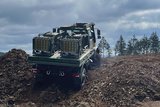Vuzix awarded DARPA development contract for next-gen display technology
Vuzix Corporation announced today that it has been awarded a research contract under the Defense Advanced Research Projects Agency's (DARPA) Persistent Close Air Support (PCAS) Program. The funding will go towards research and development of a next generation holographic optical display system for use by Joint Terminal Attack Controllers (JTAC). Vuzix has designed and recently started production deliveries of similar but current generation devices for the Battlefield Air Operations Kit (BAO). PCAS will fund the development of a high definition (HD) micro display and a see-through holographic optic. This technology is based on Vuzix' patented Blade Optical system.
The award is for $1 million and will fund a one-year development program, delivering prototype systems for integration into the larger PCAS program. PCAS will significantly increase CAS capabilities for both the JTAC and airborne platforms by developing a system of technologies that provides continuous CAS availability and lethality to the supported ground commander. PCAS will be a 'system-of-systems' approach demonstrating the ability to digitally task a CAS platform from the ground. The system will also be designed to reduce collateral damage and potential fratricide to friendly forces. Enabling technologies are: manned/unmanned airborne platforms, next generation graphical user interfaces, data links, digital guidance and control, and advanced targeting and visualization tools.
Paul Travers, Chief Executive Officer, commented, "We are very pleased to have the opportunity to develop this next generation system, which offers a competitive step-up for our military personnel. Recent advancements in micro display quality, combined with our patented Blade Optical system, are finally enabling the delivery of the HD head mounted displays (HMD's) which will help improve our ground forces' safety and effectiveness."
Source: Vuzix
More from Digital Battlespace
-
![Babcock nears first customer for Nomad AI translation tool]()
Babcock nears first customer for Nomad AI translation tool
Nomad can provide militaries with real-time intelligence, saving critical time on the battlefield.
-
![AUSA 2025: Israel’s Asio Technologies to supply hundreds of improved Taurus tactical systems]()
AUSA 2025: Israel’s Asio Technologies to supply hundreds of improved Taurus tactical systems
Taurus operates alongside the Israel Defense Forces’ Orion system which supports mission management across tens of thousands of manoeuvring forces, from squad leaders to battalion commanders.
-
![AUSA 2025: Kopin pushes micro-LED plans as China moves faster]()
AUSA 2025: Kopin pushes micro-LED plans as China moves faster
The plan for the new displays follows fresh investment in Kopin’s European facilities by Theon and an order for head-up displays in fielded aircraft, with funding from the US Department of Defense.
-
![AUSA 2025: Persistent Systems to complete its largest order by year’s end]()
AUSA 2025: Persistent Systems to complete its largest order by year’s end
Persistent Systems received its largest ever single order for its MPU5 devices and other systems earlier this month and has already delivered the 50 units to the US Army’s 4th Infantry Division.
-
![Aselsan brings in dozens of companies and systems under the Steel Dome umbrella]()
Aselsan brings in dozens of companies and systems under the Steel Dome umbrella
Turkey has joined the family of countries attempting to establish a multilayered air defence system with government approval in August 2024 for the effort landed by Aselsan. Dubbed Steel Dome, the programme joins Israel’s Iron Dome, the US Golden Dome, India’s Mission Sudarshan Chakra and South Korea’s low-altitude missile defence system.
-
![DSEI 2025: MARSS unveils new agnostic multidomain C4 system]()
DSEI 2025: MARSS unveils new agnostic multidomain C4 system
MARSS’ NiDAR system has been deployed using sensors from static platforms to provide detection and protection for static sights, such as critical infrastructure, ports and military bases.




























